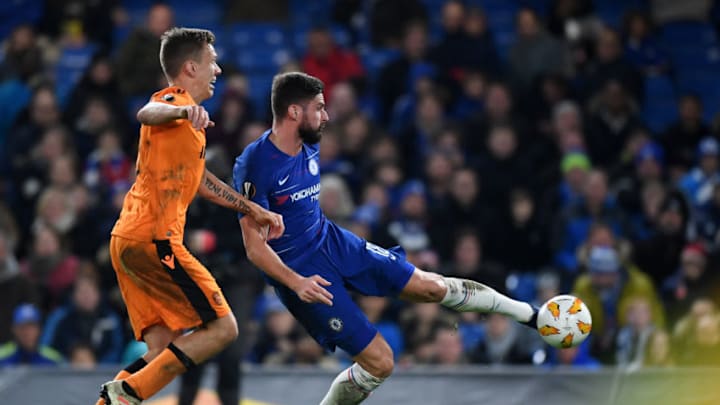Chelsea added another to their long string of performances where they create many low quality chances, and few to none better than that. They need either the personnel or the tactics to create better scoring opportunities.
Now that expected goals (xG) are becoming a regular part of football statistical parlance, it’s time to introduce a derivative metric: the ratio of shots to xG. We can call it the desperation index or pointlessness ratio (pR). For example, Chelsea had a desperation index of about 17 in their Carabao Cup tie against Tottenham. They took 17 shots, and since eight of them were from outside the box, their xG ranged from .9 – 1.08. Pretty desperate, pretty pointless.
For what it’s worth, Tottenham’s pR was about 15 if you exclude the penalty kick. They took five shots other than the spot kick, for an xG of .27. No wonder both managers would rather talk about VAR.
Chelsea played the game with their most potent scorer in his least potent position because Maurizio Sarri does not have someone he trusts as a true starting No. 9. But the Blues have the supporting cast for a target man striker. Marcos Alonso is one of the best crossers in the Premier League. Cesar Azpilicueta spent the first half of last season setting up Alvaro Morata with long diagonal passes. Callum Hudson-Odoi showed against Southampton what he provides on the right wing for service into the box.
Nominally, Chelsea still have Cesc Fabregas. But even without him, David Luiz can lump passes from deep straight up the pitch to send the striker in via Route one. And Antonio Rudiger, for his part, is better sending his passes on a slight diagonal to a striker on the inside edge of the half-spaces.
All these players can help Chelsea overcome a tight defensive block, something the Blues have struggled with all season (and longer than that). Moreover, playing an actual centre-forward potentiates Chelsea’s offence by keeping Eden Hazard in his best position on the wing. He can drop deep or to the touchline from either wing so he can dribble at the opponents, play a one-two and rush in behind the lines.
This gives Chelsea two lines of attack: the Eden Hazard show, supported mainly by those immediately around him; and the various passing lanes described above into the target man striker.
Removing the target man striker and playing Eden Hazard in the centre of the front line negates both lines. Crosses and long balls do little for Eden Hazard. And when he drops deep from the central position, he leaves a gap across a large width of the front line. This allows the opposition defence to set up their block at the top of the box, forcing Chelsea to play out wide and into their go-nowhere tippy-tappy keep-ball. The end result of that is a long, desperate, pointless shot from just outside the box.
If Chelsea are not going to play with a target man centre-forward they need to adapt their tactics to send the wingers in behind the lines and cover Eden Hazard dropping deep.
Hazard himself said that he is not the kind of player who will replicate Dries Mertens’ false-nine from Napoli. Mertens is more of a striker, Hazard said, whereas he – Hazard – is more creative. Hazard would rather dribble and create than score. This means he needs players moving around him into the space he vacates to receive the ball from him and take quality shots. When he drops deep, players need to come towards him to offer an outlet while others need to shift wide or hang off the shoulders of the opposing centre-backs. The same goes for when Hazard drifts out to the wing from the central position.
Alternatively, if Chelsea decide to buy a target man centre-forward but not exploit the many lines of service they could create for him, they must buy someone who can create opportunities on his own from the No. 9 position. All of Chelsea’s strikers – the two at the club and those on loan – need the ball played toward them if they are going to score.
This is major value proposition in someone like Edinson Cavani, particularly as a short-term stop-gap. He does not need much to find a way to score. While Maurizio Sarri trains the club to play his specific style of football, Cavani can play within but also a bit above the Sarrismo du jour to keep the goals coming. He – or someone like him – can paper over the learning process with goals that are almost independent of the system around him.
Eden Hazard can be that player, but from a left wing / No. 10 position – not from the centre. If Maurizio Sarri wants Hazard to create from nothing, he has to tolerate his No. 9’s to keep Hazard elsewhere on the pitch.
For the last few months, Chelsea had strikers but did not play a style of football that kept them properly fed. This contributed to Maurizio Sarri dropping them. But in compensating for that he diminished the effectiveness of the one player who did the most to pull Chelsea through that early stretch.
If Chelsea do not buy a Sarrismo-approved striker this month, Sarri is more likely to keep Eden Hazard as the false-nine than changing his tactics to get more out of his actual No. 9’s. This would be the worst case situation because it would alienate Hazard, reduce his effectiveness and squander the striker support offered by the rest of the club. The better option would be opening up his tactics to keep the strikers productive via their supporting players, while giving Hazard the reins to do what only he can do.
Otherwise, without new strikers or new tactics, the desperate and pointless shots will continue apace. At least now we have the metric to quantify them.
